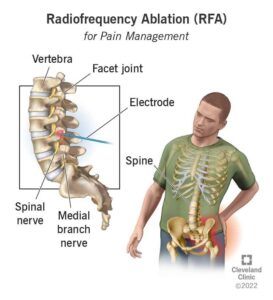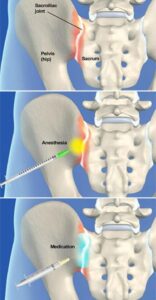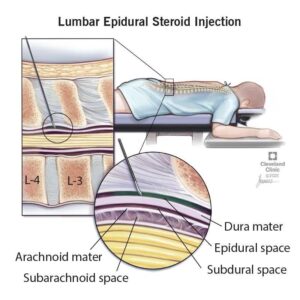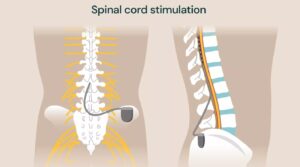Interventional Procedures For Treating Back Pain
Who is this Article for?
This article is for individuals experiencing severe, chronic pain—especially lower back pain—that hasn’t improved with conservative treatments like exercise or physiotherapy. It’s particularly relevant for those who are looking for interventional procedures for treating back pain and aren’t ready for, or want to avoid, traditional surgery.
P.S. The language used is deliberately simple and free of medical jargon.
Problem:
You’re dealing with chronic or acute back pain that:
- Interferes with your daily life, sleep, or mobility
- Doesn’t respond to conventional treatments like pills, physiotherapy, or rest
- Might be caused by herniated discs, sciatica, posture issues—or no clear diagnosis at all
- Sparks fear of surgery, or worsens because of misdiagnosis or long waiting times
Emotionally: You’re tired, frustrated, and afraid you’ll either have to live with the pain or resort to surgery. You may feel powerless—like no one is really listening to you.
What Are Interventional Procedures?
An interventional procedure is a minimally invasive procedure that using needles directed under imaging guidance to treat conditions inside the body—without large incisions or major disruption.
Because these procedures are less invasive than traditional surgery, they come with clear benefits:
- Less pain
- Faster recovery
- Little to no scarring
- Lower risk compared to open surgery
Back Pain Conditions That Benefit from Interventional Procedures
Examples of back pain that you might be experiencing—and that can be treated using interventional procedures—include pain coming from the facet joints or sacroiliac joints (which can be treated with radiofrequency ablation), inflammation in the sacroiliac or lumbar epidural areas (which may respond well to steroid injections), and nerve-related pain that hasn’t improved with other methods (which may benefit from spinal cord stimulation, first tested through a trial, then implanted if successful).
When Should You Start Considering “Interventional Procedures”?
The main goal of interventional procedures is to diagnose or treat a condition without the need for extensive surgery. These procedures aim to ease pain and provide long-lasting relief—especially for chronic, pain.
Interventional procedures can serve as both diagnostic and treatment methods for people experiencing persistent pain, particularly when the pain has built up over years and has not improved despite intensive, guided exercise and physiotherapy sessions.
I Have Severe Back Pain — Will Interventional Procedures Help Me?
For back pain, radiofrequency ablations, steroid injections, and spinal cord stimulation are all examples of interventional procedures. They use needles and imaging guidance to target the source of the pain with minimal disruption to the surrounding tissues.
Okay, let’s break down each of these procedures in a super simple way you’ll understand—no medical degree required!
- Radiofrequency ablations (RFA) to “denervate” the facet joints:
-
- Simple meaning: This procedure uses heat (generated by radio waves) to essentially “turn off” the small nerves that send pain signals from your facet joints (the small joints in your spine).
- Why is it done? If pain is coming from these specific joints, numbing the nerves that carry the pain signal can provide long-lasting relief. “Denervate” just means to stop these nerves from working.
Figure 1 https://my.clevelandclinic.org/health/treatments/17411-radiofrequency-ablation
- Sacroiliac joint steroid injections:
- Simple meaning: This is an injection of a strong anti-inflammatory medicine (a steroid) directly into your sacroiliac joint (the joint connecting your lower spine to your pelvis).
- Why is it done? To reduce inflammation and pain within that specific joint.
Figure 2 https://southeasternspine.com/service/sacroiliac-joint-steroid-injection/
- Sacroiliac joint radiofrequency ablations to “denervate” the posterior capsule of the joint:Simple meaning: Similar to the RFA for facet joints, this uses heat to “turn off” the nerves specifically around the back part (posterior capsule) of your sacroiliac joint.Why is it done? If pain is coming from these specific nerves around the sacroiliac joint, disabling them can help reduce pain.
- Lumbar epidural steroid injections for spinal canal stenosis pain: Simple meaning: This is an injection of steroid medicine into the “epidural space,” which is the area just outside the protective sac around your spinal cord in your lower back (“lumbar” region).Why is it done? “Spinal canal stenosis” means the spinal canal (the tunnel where your spinal cord and nerves are) has narrowed, often pinching nerves and causing pain, numbness, or weakness. The injection can provide pain relief.
Figure 3 https://my.clevelandclinic.org/health/treatments/22091-lumbar-epidural-steroid-injection
- Spinal Cord Stimulation Device Implantation: This is a two-step process:
- Spinal Cord Stimulator Trial:
- Simple meaning: A temporary test where thin wires are placed near your spinal cord (often in the epidural space) and connected to a small external device you wear. This device sends mild electrical pulses that can change how your brain perceives pain, often replacing it with a tingling sensation or just reducing the pain.
- Why is it done? To see if the spinal cord stimulation actually works for your pain before a permanent device is implanted. It’s like trying on a pair of shoes to make sure they fit.
- Spinal Cord Stimulator Implant:
- Simple meaning: If the trial is successful, a small, permanent device (like a pacemaker) is surgically placed under your skin, usually in your buttock or abdomen, and connected to wires placed near your spinal cord. This device continuously sends those mild electrical pulses.
- Why is it done? For long-term management of chronic pain that hasn’t responded to other treatments. The device helps interrupt pain signals before they reach the brain.
- Spinal Cord Stimulator Trial:
Figure 4 https://guysandstthomasspecialistcare.co.uk/news/news-spinal-cord-stimulation-reduces-patients-pain/
Solution: How Can You Move Forward?
Non-surgical, image-guided pain relief procedures that:
- Precisely target the source of your pain
- Are minimally invasive (using needles, not scalpels)
- Provide fast relief with minimal downtime
- Are backed by diagnostics like MRI and thorough physical evaluations
- Are delivered by a specialized doctor—Dr. Samer—who has extensive experience in pain medicine. Check out his profile here.
We at Dr. Samer’s pain clinic help people struggling with pain find relief without surgery. Through image-guided, minimally invasive procedures, we precisely treat the source of your pain so you can move freely again, sleep well, and reclaim your life!
🗓️ Book your first session here: https://samerpainclinic.com/contact-us/
🗓️ Call or WhatsApp us here: https://wa.me/962790922204
Feel free to send your questions or concerns to our email here: [email protected]







